When to Quarantine a Sick Chinchilla From Others
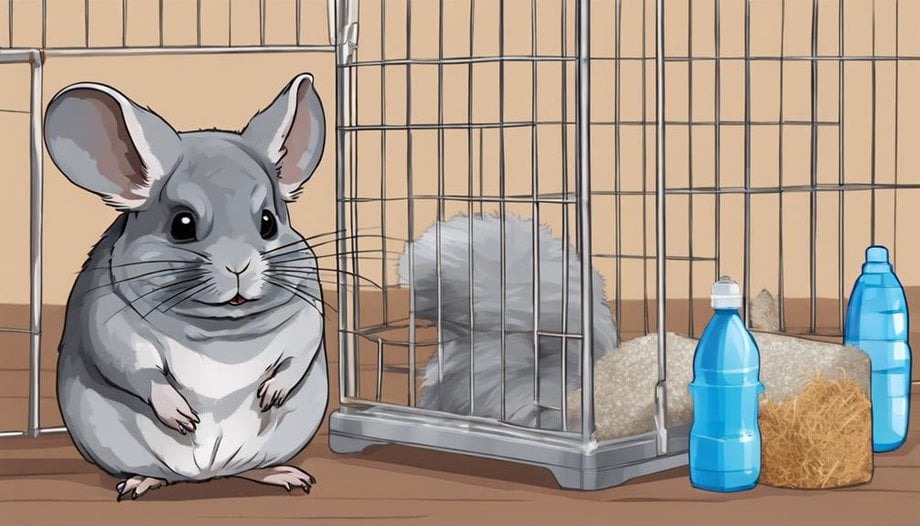
Quarantine is necessary when a chinchilla shows signs of illness to prevent the spread of disease to other chinchillas. It is important to isolate the sick chinchilla in a separate cage with its own food, water, and bedding. This will help minimize the risk of transmission to other pets in the household and allow for closer monitoring of the sick chinchilla's condition. Additionally, quarantining the sick chinchilla will make it easier to provide any necessary medications or treatments without affecting other animals. Remember to wash your hands thoroughly after handling the sick chinchilla to prevent the spread of any potential pathogens.
Recognizing Symptoms of Illness
When observing a chinchilla for signs of illness, it's essential to pay close attention to any changes in behavior or physical symptoms. Recognizing symptoms early can make a significant difference in the chinchilla's well-being. Some common signs of illness in chinchillas include decreased appetite, lethargy, diarrhea, sneezing, discharge from the eyes or nose, hair loss, and hunching posture. If any of these symptoms are observed, it's crucial to seek treatment promptly to prevent the condition from worsening.
Chinchillas are masters at hiding their illnesses, so being attentive to subtle changes is key. As caregivers, it's important to monitor their daily habits and behaviors closely. Any deviation from their usual routine could be a sign that something is amiss. Seeking treatment from a veterinarian experienced in chinchilla care is vital. Prompt intervention can help alleviate the chinchilla's discomfort and facilitate a quicker recovery. Remember, early detection and treatment can greatly improve the chinchilla's chances of returning to good health.
Importance of Early Detection
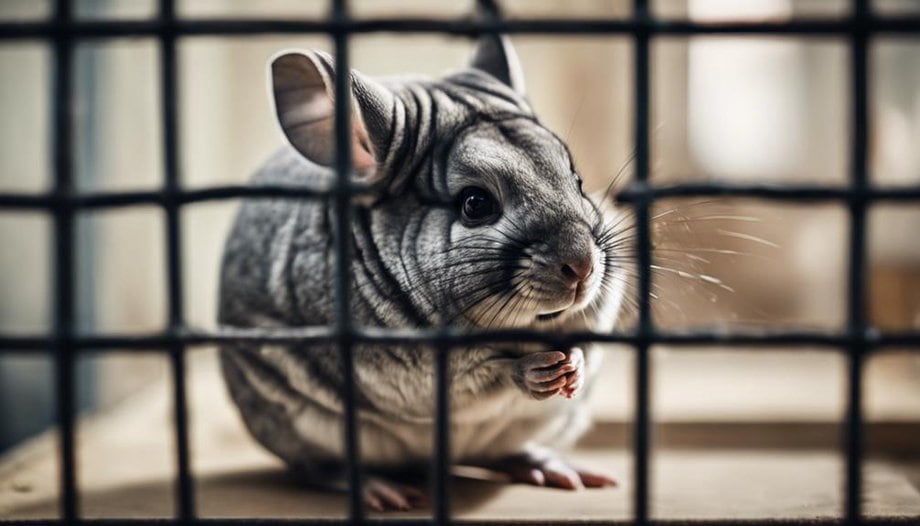
Early detection of illness in chinchillas is crucial for their well-being. Identifying symptoms promptly can save lives and prevent the spread of disease within a group of chinchillas.
Isolating a sick chinchilla early on minimizes the risks of further contamination and ensures timely treatment.
Early Detection Saves
Detecting signs of illness in a chinchilla at the earliest stage can significantly improve their chances of recovery and well-being. Early intervention is key to providing the necessary treatment options and implementing effective quarantine management. By spotting symptoms promptly, caregivers can swiftly address the chinchilla's health concerns, preventing the condition from worsening. Here is a table highlighting the importance of early detection:
| Early Detection Saves |
|---|
| Timely treatment |
| Prevents complications |
| Minimizes spread of illness |
| Increases chances of recovery |
This table emphasizes how being vigilant about chinchilla health and acting promptly can make a substantial difference in the outcome of their well-being.
Prevent Spreading Illness
To effectively prevent the spread of illness in chinchillas, prompt identification of symptoms and immediate isolation measures are crucial. Implementing preventive measures such as regular health check-ups and maintaining strict containment strategies can help in early detection of potential illnesses.
Following established health protocols and isolation guidelines is essential to safeguard the well-being of the chinchilla community. By being vigilant and proactive in observing any changes in behavior or physical condition, caregivers can swiftly address health concerns and prevent the spread of diseases.
Timely intervention not only protects the affected chinchilla but also minimizes risks to other individuals in the group. Prioritizing early detection and swift isolation demonstrates a compassionate commitment to the welfare of these sensitive animals.
Isolation Minimizes Risks
Implementing immediate isolation measures is crucial in minimizing risks and safeguarding the well-being of chinchillas when symptoms of illness are identified. Isolating a sick chinchilla can prevent the spread of infectious diseases, allowing for prompt treatment and reducing the chances of an outbreak among other chinchillas. By separating the sick chinchilla from healthy ones, you not only protect the rest of the group but also give the ill chinchilla a better chance at recovery. Isolation benefits include controlling the spread of illnesses, managing risks effectively, and ensuring a healthier environment for all chinchillas involved. Early detection and isolation are key components of risk management when dealing with sick chinchillas, emphasizing the importance of proactive care and attention to their well-being.
| Isolation Benefits | Risk Management | Healthy Environment |
|---|---|---|
| Controls spread of illnesses | Minimizes outbreak risks | Promotes well-being |
| Ensures prompt treatment | Protects other chinchillas | Improves recovery chances |
| Prevents disease transmission | Manages health risks | Enhances overall health |
| Supports individual care | Reduces contagion risks | Fosters a safe space |
| Facilitates monitoring | Enhances risk assessment | Encourages early intervention |
Establishing a Quarantine Area
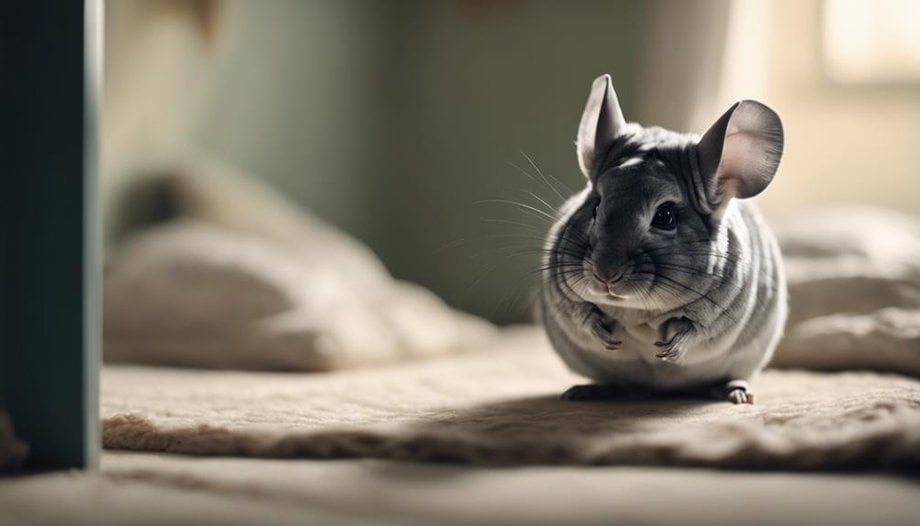
Setting up a designated quarantine area is crucial when caring for a sick chinchilla to prevent the spread of illness to other pets. When establishing a quarantine area, consider the following:
- Select a Quiet Location: Choose a peaceful area away from the main living space to reduce stress on the sick chinchilla.
- Provide Proper Ventilation: Ensure good airflow in the quarantine area to maintain a healthy environment.
- Use Easy-to-Clean Materials: Opt for surfaces that are simple to clean and disinfect to prevent the spread of germs.
- Monitor Progress and Health Updates: Keep a detailed record of the chinchilla's symptoms, any changes in health status, and responses to treatment.
Monitoring Behavior and Vital Signs
When caring for a sick chinchilla in a designated quarantine area, it's essential to closely monitor its behavior and vital signs to track its progress and response to treatment. Monitoring behavior involves observing the chinchilla for any changes in activity levels, grooming habits, eating patterns, and social interactions. Any unusual behavior such as lethargy, aggression, or excessive hiding should be noted as it could indicate distress or discomfort.
Vital signs such as body temperature, respiratory rate, and heart rate should be regularly assessed. A healthy chinchilla has a body temperature between 98.6-100.4°F, a respiratory rate of 40-80 breaths per minute, and a heart rate of 100-160 beats per minute. Any deviations from these ranges may indicate an underlying health issue that requires attention.
Additionally, assessing symptoms like sneezing, discharge from the eyes or nose, diarrhea, or changes in coat condition is crucial in recognizing signs of distress. Promptly identifying and addressing these symptoms can help in providing the necessary care and treatment for the sick chinchilla.
Consulting a Veterinarian
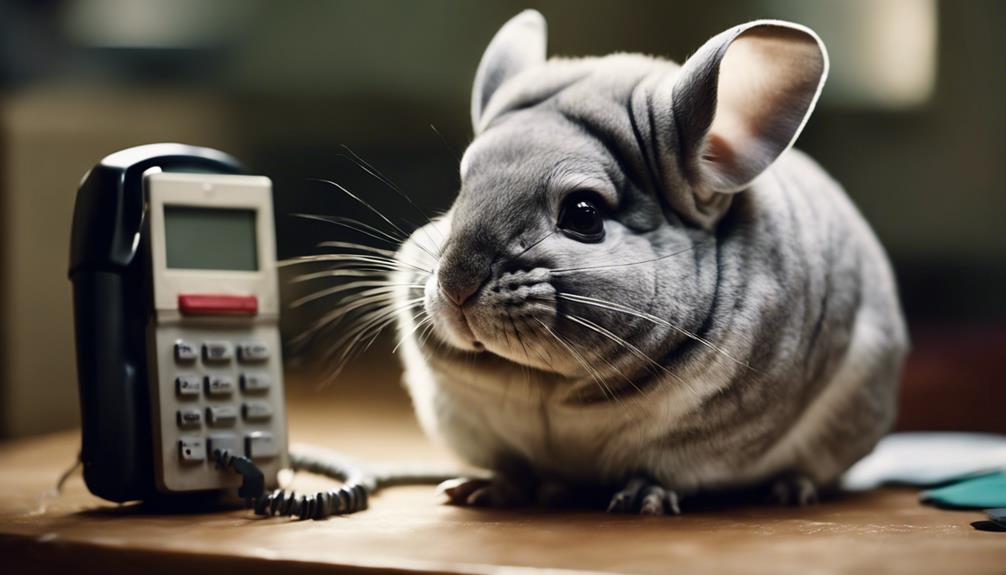
Consulting a veterinarian is crucial when caring for a sick chinchilla to ensure accurate diagnosis and appropriate treatment. Seeking veterinary guidance early on can significantly impact the chinchilla's recovery process. Here are some key points to consider when consulting a veterinarian:
- Veterinary Guidance: A knowledgeable veterinarian can provide valuable insights into the chinchilla's condition and recommend suitable treatment options.
- Quarantine Protocol: The vet can advise on the proper quarantine procedures to prevent the spread of any contagious diseases to other chinchillas.
- Health Assessment: Through a thorough examination, the veterinarian can assess the chinchilla's overall health status and identify any underlying issues contributing to its sickness.
- Isolation Procedure: If quarantine is necessary, the vet can guide you on how to effectively isolate the sick chinchilla to minimize stress and ensure a conducive recovery environment.
Consulting a veterinarian not only ensures the well-being of the sick chinchilla but also plays a vital role in maintaining the health of the entire chinchilla community.
Duration of Quarantine Period
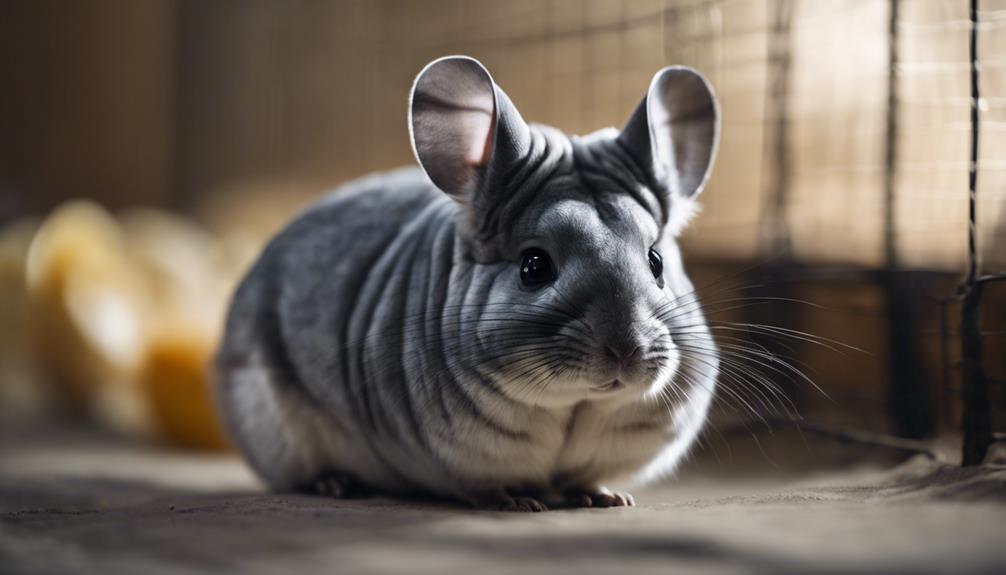
Upon confirming the need for quarantine as advised by the veterinarian, the duration of the quarantine period for a sick chinchilla should be carefully determined based on the specific illness and recovery progress. The quarantine duration is typically recommended to last for at least two weeks to prevent the potential spread of the illness to other chinchillas. However, in cases of more severe or contagious illnesses, the quarantine period may need to be extended based on veterinary guidance.
During the quarantine period, it's crucial to take necessary precautions to minimize the risk of transmission. This includes separating the sick chinchilla from healthy ones to prevent direct contact and potential spread of the disease. Additionally, interactions with the sick chinchilla should be limited to essential care activities to reduce exposure.
Monitoring the sick chinchilla's recovery progress closely during quarantine is essential. Once the chinchilla shows significant improvement and is deemed no longer contagious by the veterinarian, reintroduction to chinchilla companions can be considered, as discussed in the next subtopic.
Reintroduction to Chinchilla Companions
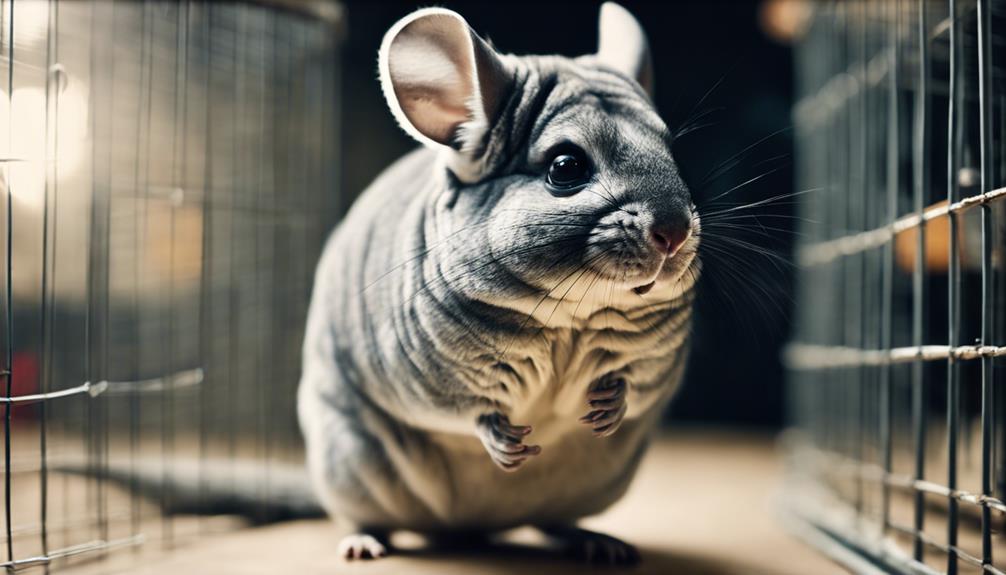
When reintroducing chinchilla companions, it's crucial to monitor their interactions closely.
Reuniting chinchilla friends after a period of separation may require patience and gradual reintroduction.
Socializing chinchilla pairs can help strengthen their bond and ensure a smooth transition back to companionship.
Reuniting Chinchilla Friends
As chinchillas are social animals, carefully reintroducing them to their companions after a period of separation is crucial for their well-being and happiness. When reuniting chinchilla friends, consider the following:
- Behavior Changes: Monitor any unusual behaviors as chinchillas adjust to being together again.
- Reintroduction Process: Slowly reintroduce chinchillas in a neutral territory to prevent aggression.
- Friendship Dynamics: Observe how the chinchillas interact to ensure they're comfortable with each other.
- Health Precautions: Before reuniting, ensure both chinchillas are healthy to prevent the spread of any illnesses.
Socializing Chinchilla Pairs
After ensuring that the chinchillas are healthy and ready for reintroduction, it's important to facilitate the socializing process between chinchilla pairs with care and consideration for their well-being and comfort. Bonding activities play a crucial role in helping chinchillas re-establish their bond and strengthen their relationship.
Socialization techniques such as supervised playtime in a neutral area can help chinchillas get reacquainted in a safe environment. Providing enrichment activities like toys and treats can also aid in creating positive associations between the chinchillas. It's essential to monitor their interactions closely, looking for signs of stress or aggression.
Patience and understanding are key during this process, as each chinchilla may have different needs and preferences when it comes to socializing with their companion.
Pairing Chinchilla Companions
To successfully reintroduce chinchilla companions, it's crucial to create a gradual and controlled environment that fosters positive interactions between the chinchillas. Here are some key steps to consider:
- Slow Introduction: Start by placing the chinchillas in separate but adjacent enclosures to allow them to get used to each other's presence.
- Supervised Interaction: Once the chinchillas seem comfortable, allow them to interact under close supervision to prevent any aggressive behavior.
- Monitor Behavioral Changes: Keep a close eye on their behavior during interactions, looking for signs of stress or discomfort.
- Encourage Social Bonding: Provide opportunities for the chinchillas to engage in activities together, such as playtime or grooming, to strengthen their bond.
Frequently Asked Questions
Can Chinchillas Transmit Illnesses to Other Pets in the Household?
Chinchillas can transmit illnesses to other pets in the household through cross-species transmission. To prevent this, it's crucial to practice household containment by isolating the sick chinchilla. This measure protects the well-being of all furry companions.
Are There Specific Disinfection Protocols Recommended for the Quarantine Area?
Disinfection procedures play a crucial role in isolating a sick chinchilla. Regularly clean and disinfect the quarantine area to prevent the spread of illness. It's essential to follow strict precautions and monitor the chinchilla's health during isolation.
Should Chinchillas in the Same Household Be Separated Even if Only One Is Showing Symptoms?
When one chinchilla shows symptoms, separating it from others is crucial to prevent spreading illness. Social interaction might increase stress levels, impacting behavior. Isolation helps protect the health of the entire group, ensuring a safe and healthy environment.
How Often Should Vital Signs Be Monitored During the Quarantine Period?
During the quarantine period, it's essential to monitor the sick chinchilla's vital signs regularly. This includes checking its temperature, respiratory rate, and heart rate. These checks should be done frequently to ensure the chinchilla's well-being.
Are There Any Specific Dietary Changes Recommended for a Chinchilla in Quarantine?
During quarantine, a sick chinchilla may benefit from dietary changes to support its nutritional requirements and hydration levels. It's crucial to provide a balanced diet rich in fiber, hay, and fresh water to aid in recovery.











